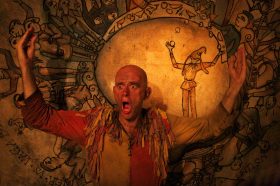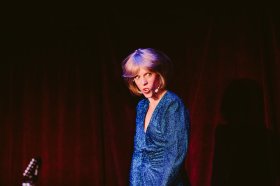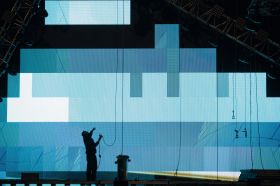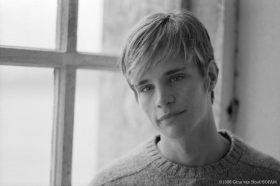Photo: Andrea Evans
Gaston Leroux’s 1910 novel was partly inspired by historical events at the Paris Opera during the 19th century. It carries a typically Victorian melodramatic story (the dramatic theme is almost a carbon copy of the Svengali-Trilby relationship in George du Maurier’s novel) and was thus a prime candidate for adaptation to the stage and screen in various formats. Starting in 1925, Phantom has been made into a film at least ten times, most recently as a filmed version of the 1986 Andrew Lloyd Webber musical.
There was an earlier musical with book and lyrics by English playwright, director and musical adaptor Ken Hill. Prompted by its good reviews, Andrew Lloyd Webber approached Hill about the possibility of their collaborating on a grand scale redevelopment of Hill’s version of Phantom for the West End. However, Lloyd Webber eventually decided to go it alone, and thus the 1986 juggernaut was born.
An American musical version was created in 1991, with music and lyrics by Maury Yeston and a book by Arthur Kopit. Although well-received, this has, like Hill’s work, been overshadowed by Lloyd Webber’s opus.
Given the setting, it is not surprising that all three offerings drew on the operatic repertoire; in fact, ‘The Music of the Night’ was the subject of a lawsuit by the Puccini estate, which claimed it was plagiarised from that composer’s 1910 opera, The Girl of the Golden West. As is typical of Lloyd Webber, Phantom is noted for serving up lyrical, lovely melodies, including ‘Music of the Night’, ‘Angel of Music’ and ‘All I Ask of You’.
It was these beautiful solos and duets, performed by professionals, that lifted this production from its essentially amateur status. It has long been the goal of producer/director Ian Charles Westrip to see a third state company in Western Australia: one devoted to musical theatre. His recent productions have indicated that there is certainly an audience for such works. In engaging Aldo di Toro for the title role in Phantom, Westrip has proved that WA audiences will pay good money to see quality performances. The other principals, Stephanie Gooch as Christine and Nick Maclaine as Raoul, also delivered practiced, in-character performances, and the players of the smaller roles were all fully competent. And it was fun to hear Ian Westrip himself in the off-stage role of Maestro Reyer, the chorus master. Now there’s a nice bit of type-casting!
However, the production was a bit of a curate’s egg. The let-down lay in the chorus work and the dancing. Both chorus and dancers were technically accomplished: I did not hear a single wrong note or see even one fluffed step. However, in Act One, the performers simply didn’t give us the kind of immersive experience we expect from a fully professional company. This may have been partly because of the difficulty of working a large cast on a small stage. (Subiaco’s Regal is a lovely old theatre, but the acting area is less than ideal for a large cast such as this.)
But the main problem, I think, was that the chorus and the dancers were not fully engaged in their roles. Yes, even dancers and members of the chorus must play roles. If you do not believe yourself to be, for example, for the couple of hours you’re on stage, a turn-of the century ballet girl or stage hand, your performance will be lacking. This kind of immersion is not easy, and is only accomplished with many more hours of rehearsal than can be expected from people who have day jobs or studies that take up the bulk of their time. Learning the notes and the choreography constitute big enough demands.
I must say that Act Two was wonderful. The cast had relaxed and everyone was in character. The first act of Phantom is extremely demanding on the chorus and the dancers, while Act Two focuses more on the leading roles, so the feeling of disconnectedness that spoilt Act One had vanished.
And there lies the rub. Musicals, as a rule, demand huge casts. There were over 50 performers in this production, and that’s before we consider backstage and front-of-house. The idea of paying full Alliance rates to each performer is mind-boggling and no doubt impossible for a company with no outside funding.
But if we were to judge the production on its own merits as being presented by an under-rehearsed, semi-pro company, this would be a five star production. The sets were clever and versatile (that boat in the mist sent shivers up my spine) the wardrobe was attractive, the orchestra was well-rehearsed and proficient, the choreography was excellent as a reproduction of the era and the principals were nothing less than outstanding. However, if the company is ever to become fully professional, it must be judged by the standards that apply to professionals, so one star is missing.
Rating: 4 stars out of 5
ICW Productions presents
The Phantom of the Opera
Director: Mark Barford
Producer and Musical Director: Ian Westrip
Assistant Musical Director: Jangoo Chapkhana
Choreographer: Ben Franzen
Set and Costume design: Steve Nolan
Lighting Design: Jenny Vila
Sound Design: Dave Keys
Stage Manager: Emma Barbaro
Regal Theatre, Subiaco, WA
2-11 October





